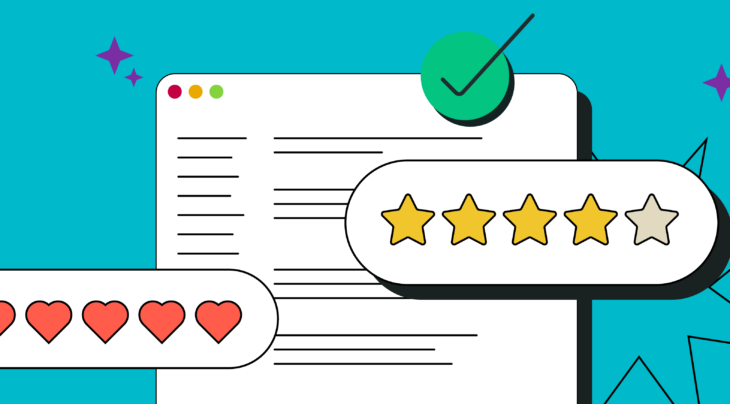Should you quickly sell a product now or build relationships that will pay off in the future? This question puzzles business owners all the time, but reality shows that only big companies are ready for the long game. The rest are struggling for revenue, mastering short term tactics that bring ROI right away.
These tactics are called direct response marketing and sometimes are considered intrusive, as people don’t want to be sold to. But if Jamie Oliver was a marketer, he would say, “you just have to cook it right!” In this blog post, we’ve gathered all the best recipes: mix, test, and win the check!
- What is direct response marketing?
- Direct response marketing pros and cons
- Direct response marketing tactics: pick the right channels
- Direct response marketing tactics: target specific audiences
- Direct response marketing tactics: make a limited time offer
- Direct response marketing tactics: use a strong CTA
- Direct response marketing tactics: make it easy to react
- Direct response marketing tactics: track and measure outcomes
- In summary
What is direct response marketing?
Direct response marketing is online or offline advertising that motivates people to take an immediate action like making a purchase, registering for an event, referring a friend, downloading an app, or any other objective you’re seeking.
It is called “direct” because you communicate directly with a person you are selling to. This person can be a lead from your current database or a potential customer. In comparison to indirect or inbound marketing, direct response marketing is point-blank and doesn’t bother with nurturing leads or building relationships.
In most marketing channels, both direct and indirect marketing strategies can be used. Here are some examples:
| Direct marketing channels | Indirect marketing channels |
| Paid ads and retargeting | SEO |
| Direct sales calls and meetings | News articles and press |
| Promotional email campaigns and offline mail | Email content marketing |
| Print ads and point-of-sale materials | Useful blog posts |
| Paid ads and retargeting on social media | Social media pages and groups |
| Offline events, street marketing, exhibitions | Word of mouth |
| Pre-roll ads on video platforms | Video content marketing |
| TV, radio, and outdoor commercials | Partnerships and sponsorships |
| Referral programs | UGC and online reviews |
| Pop-ups and giveaways as lead generation | Lead generation with lead magnets |
| SMS, push notifications, and chatbot messages | Useful chatbots for awareness and consideration |
Now let’s sink into the pros and cons of direct response marketing and grab some workable tactics.
Direct response marketing pros and cons
When done right, direct response marketing brings you ROI almost immediately. But there’s two sides to every coin: the best converting channels are highly competitive and can require huge investments to be successful.
Have a look at the marketing budget allocation chart from the State of Ad Tech 2019 Report by Criteo. If you sum up all the direct response marketing channels, you will see that they compose the biggest part of a pie.
Marketing budget allocation by channel in 2019
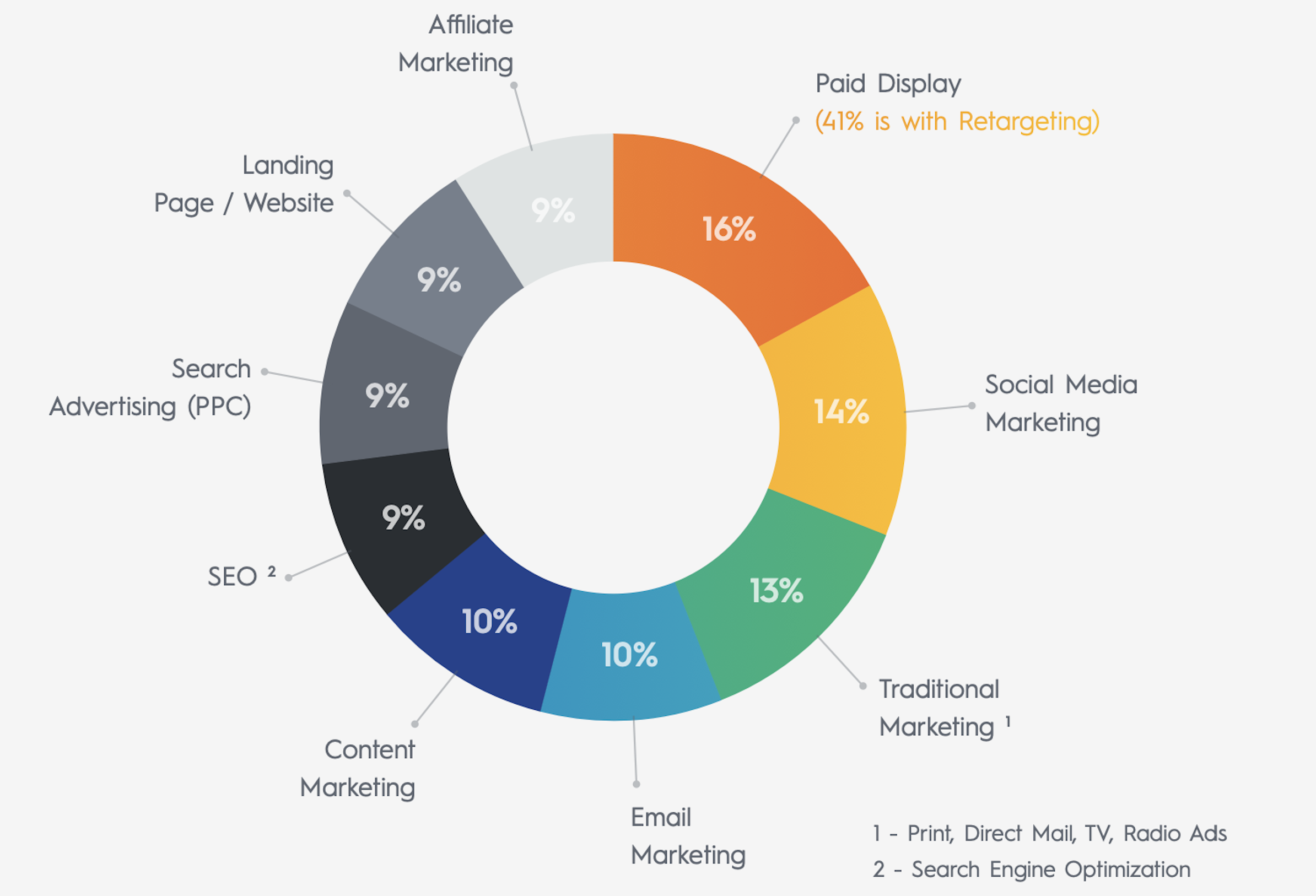
So, the pros of using direct response marketing are:
- a quick return on investment;
- there’s a variety of channels and tactics to try;
- you can easily track and estimate the results.
The cons are:
- you’ll have to invest;
- you will not build brand recognition or solid relationships;
- you can turn away your customers or prospects with irrelevant ads.
Сonsidering all the pros and cons and the fact that most of the decisions take time, use a mix of inbound and direct response marketing tactics. For example, invest your time into content marketing to help your clients through the awareness and consideration stages and convert them into sales with a targeted direct response campaign.
Direct response marketing tactics: pick the right channels
Only well-converting channels and campaigns will bring you the desired return on investment. But, how can you know which ones will work for you?
What usually happens is: marketers test and iterate, evaluate the ROI, and then scale up the best performing campaigns. That’s why paid digital advertising is sometimes called performance marketing. And this is a never-ending story because advertising platforms evolve, audiences shift, and shopping behaviors change.
So, what should you start with? Look at these market trends and best practices. In the above-mentioned report from Criteo, they asked marketers which channels they typically use to drive conversions. Here are the answers:
The highest converting marketing channels in 2019, % shows the number of marketers who use the channel
| Social media marketing | Paid display advertising | Email marketing | Search engine optimization |
| 53% | 43% | 41% | 38% |
The top three can be used in direct response marketing and are well worth the effort.
Social media marketing
Only part of the activities here can be considered direct response marketing tactics. These are paid advertising options that allow you to create ads and show them to the right audiences in different formats. And let’s give social media some credit: the number of formats and targeting options is mesmerizing.
Here are the most popular social platforms worldwide, as of April 2020:
Social networks ranked by number of active users, in millions
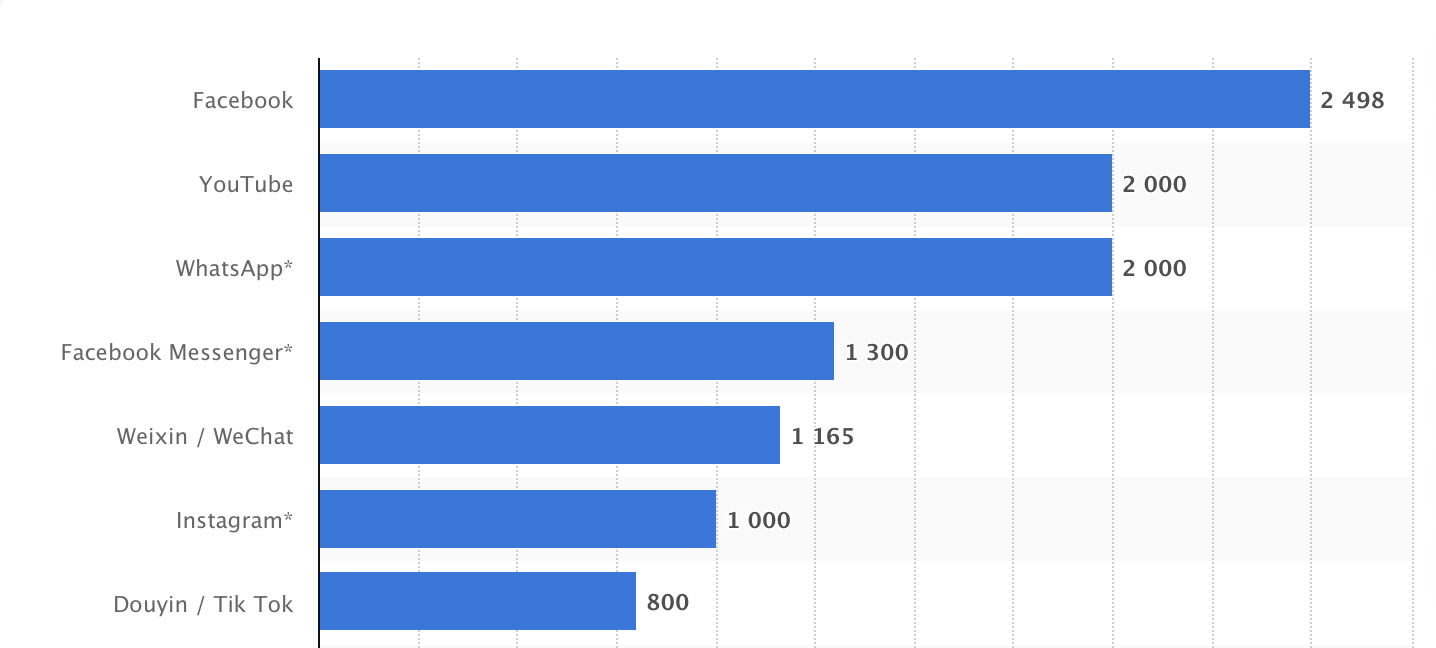
Facebook is the number one social platform based on its number of active users and has a variety of advertisement mechanics to take advantage of. It also has guides and suggestions depending on the goal of your campaign. For instance, it offers conversions, catalog sales, and store traffic as direct response marketing goals:
| Objective | Business goal |
| Conversions | Encourage people to take a specific action on your business’s site, such as having them add items to a cart, download your app, register for your site, or make a purchase. |
| Catalog Sales | Show products from your eCommerce store’s catalog to generate sales. |
| Store Traffic | Promote your brick-and-mortar business locations to people that are nearby. |
To reach these objectives, Facebook has five ad formats: image, video, carousel, instant experience, and collection. To get the best results for your direct response marketing activities, platform developers suggest creating custom ad experiences for people who are unfamiliar with your business and for those who have purchased from you before.
Here is an example of an image Facebook ad from Wild Code School. It has a high-quality image, a great offer, and a call to action: subscription. If you look at the link in the button, you will also see that they use UTM tags to track the efficiency of the ad.
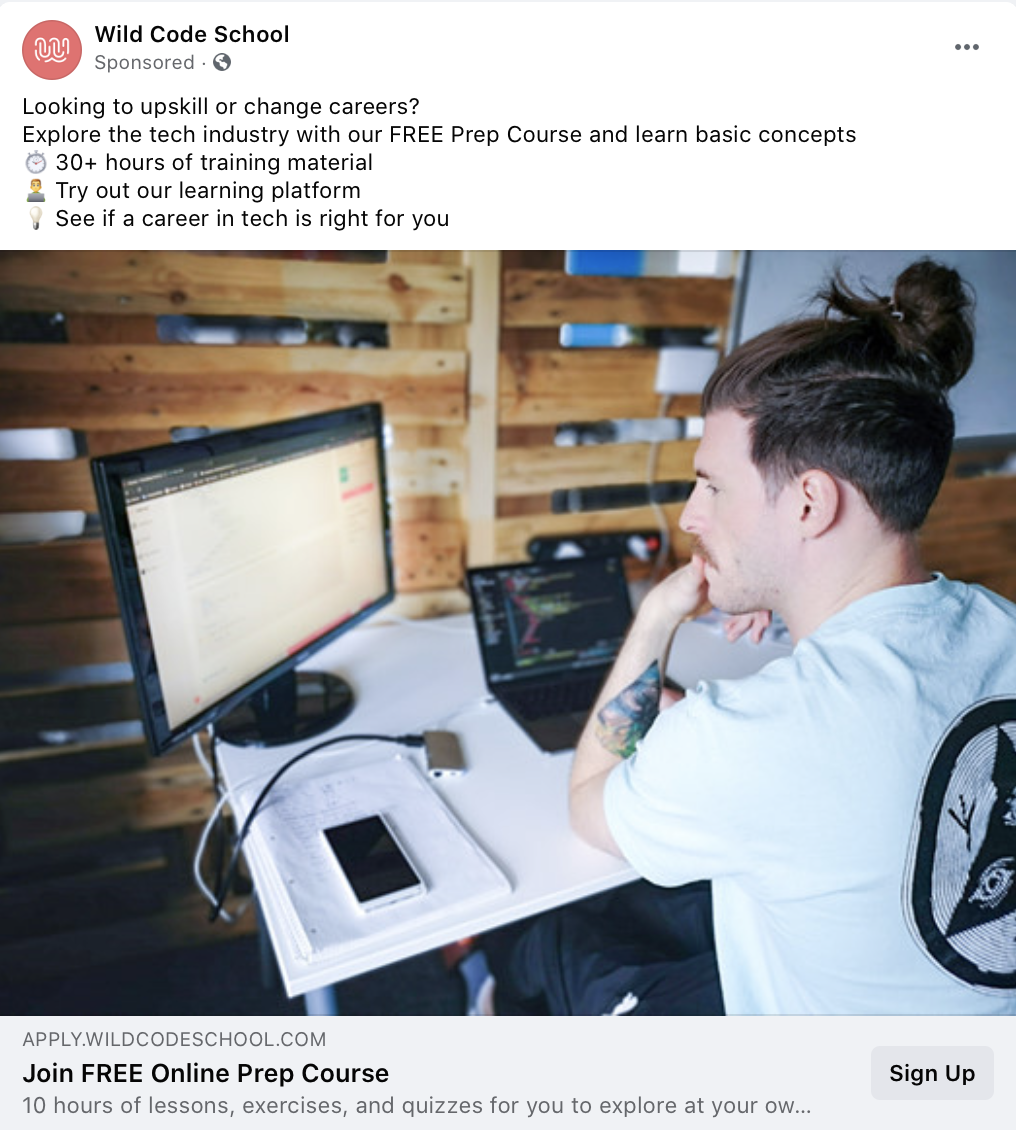
The number two social media platform, in terms of active users, is YouTube. There are five ad formats you can use here: skippable in-stream ads, non-skippable in-stream ads, bumper ads, video discovery ads, and masthead ads. You will need tailored video creatives with messages that are straight to the point and compelling enough.
Best practice: Use TrueView for action campaigns to drive leads and conversions. This type of YouTube video campaign allows you to add CTAs, headline text overlays, and an end screen to video ads.
Here is an example of a YouTube ad. There is a CTA banner in the bottom right corner. If you hit the button, you’ll be directed to the website. This ad cannot be skipped for the first five seconds, so your prospects will be able to evaluate the message and take action.
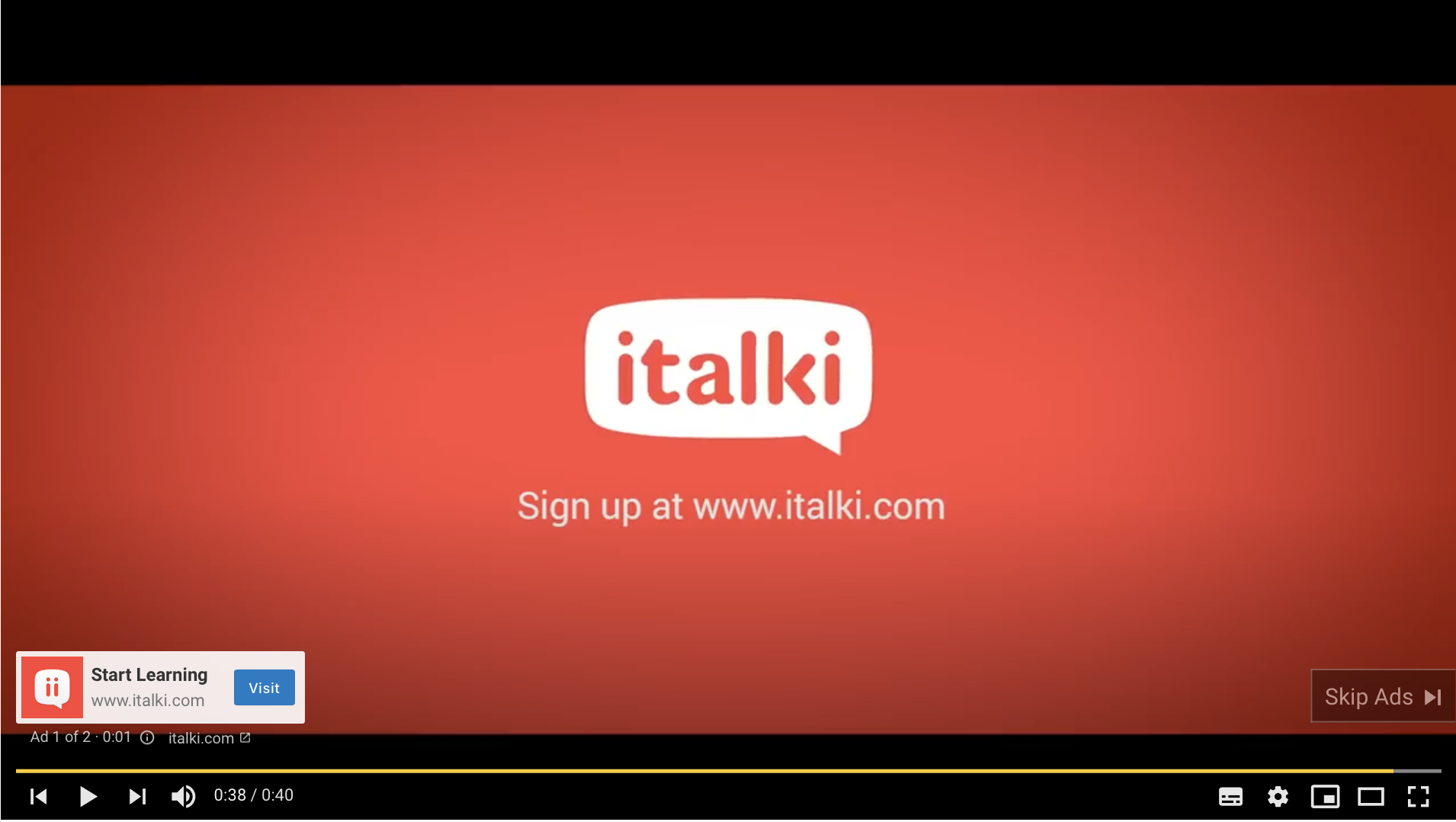
The next three positions in the list of top social media platforms are occupied by messengers: WhatsApp, Facebook Messenger, and WeChat. Apart from offering big audiences, they have the highest conversion rates, even beating email marketing campaigns. That’s why marketers should definitely start looking at messenger marketing techniques and become an early adopter.
Neil Patel
The early adopters of SEO were able to dominate the SERPs and gain massive organic search traffic. The early adopters of Facebook groups built massive followings. The early adopters of Twitter created huge brands and cultivated enormous influence.
The earlier you learn and use a new marketing tactic, the more likely you are to benefit from it. It’s the perfect time to use Facebook Messenger bots.
WhatsApp still doesn’t have any advertisement options and tools for businesses. The only thing to do here now is to create groups with up to 256 members by adding people or asking them to join. For instance, this could be a closed group for loyal customers with VIP discounts. This strategy can also be used on Slack, Telegram, or Viber.
For instance, the beauty company, Glossier, created a closed group on Slack for its loyal consumers to get feedback, promote special offers and member-only discounts.
When it comes to Facebook Messenger, there are some advertisement options that work like the other of Facebook ad formats. You can even use the same creative assets that you’re using for Facebook and Instagram, including stories!
There is another perk with using Facebook Messenger: you can launch chatbots to deliver promotional offers to the potential or current consumers. For instance, it could be an offer with a welcome discount or an invitation to a test-drive.
Paid display advertising
Google Ads claims to help marketers drive a high volume of conversions at the lowest price. There are two types of advertising: paid search and paid display ads. Both can be used in your direct response campaign, but according to Criteo stats, display ads are better for driving conversions.
Display ads are managed by Google Display Network which has a contextual targeting engine. This engine shows your ad to the most relevant audiences before, during, and after the person makes a search.
Let’s assume you have a kitchen supplies store and launch a Google display ad with a special offer. Your potential customers will see it on the websites with recipes, online cooking shows, or even inside some mobile cooking apps. This allows you to reach the most motivated audiences at the right moment.
Best practice: Use retargeting to re-engage with customers who already know you with personalized offers.
The ad types you can run on Google Display Network are responsive display ads, uploaded image ads, engagement ads, Gmail ads. Here is an example of a Google Display Network ad on Buzzfeed:
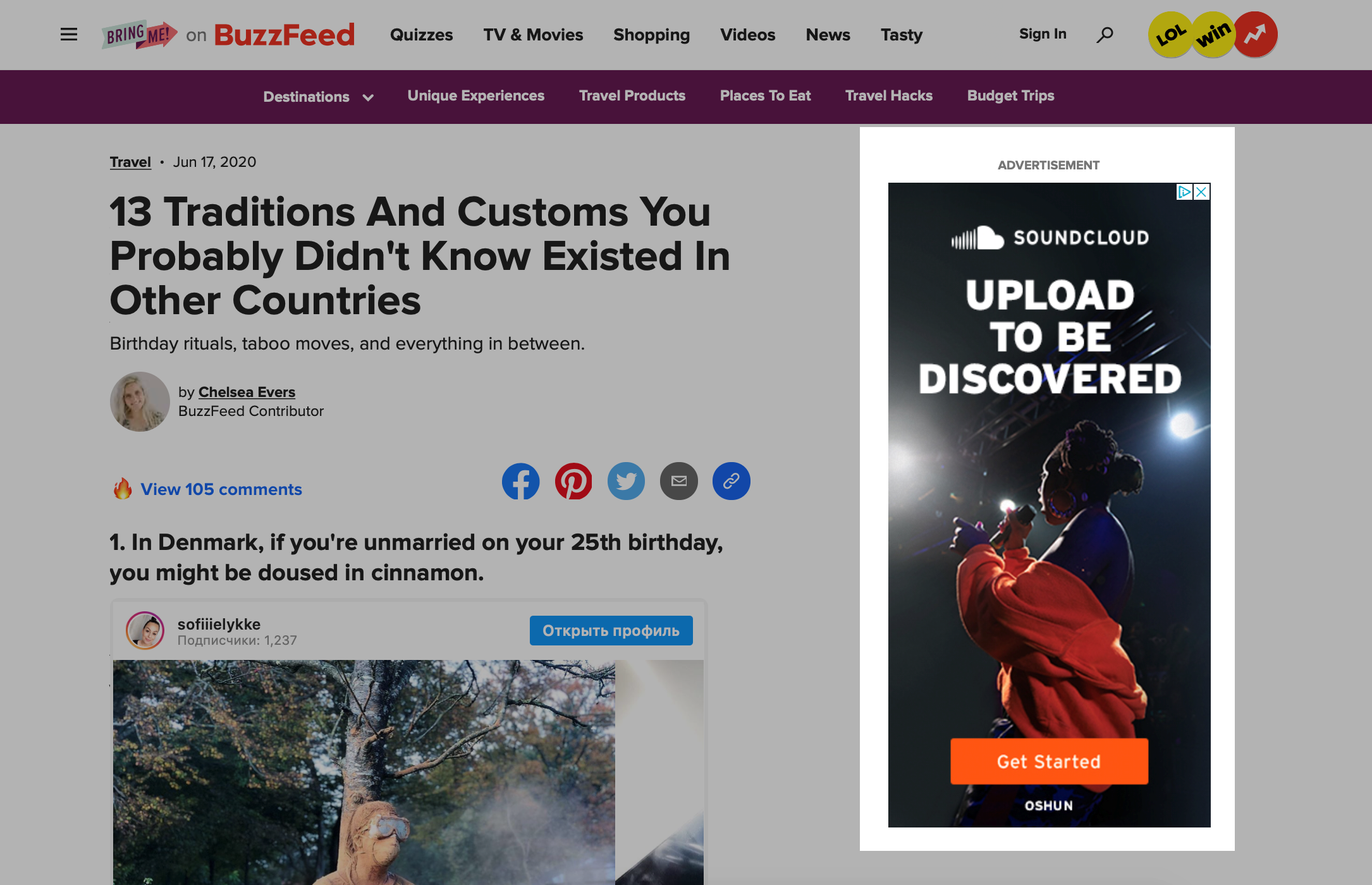
The pricing models used here are cost-per-thousand-impressions (CPM), cost-per-click (CPC), and cost-per-action (CPA) which allows you to adjust the analytics and budgets for your business goals.
Email and direct mail marketing
You can use email marketing as one of the direct response marketing tactics only with your current database. For example, sending promotional or seasonal emails. A great example of such en email driving an immediate action are Black Friday email campaigns, welcome discounts, and sales:
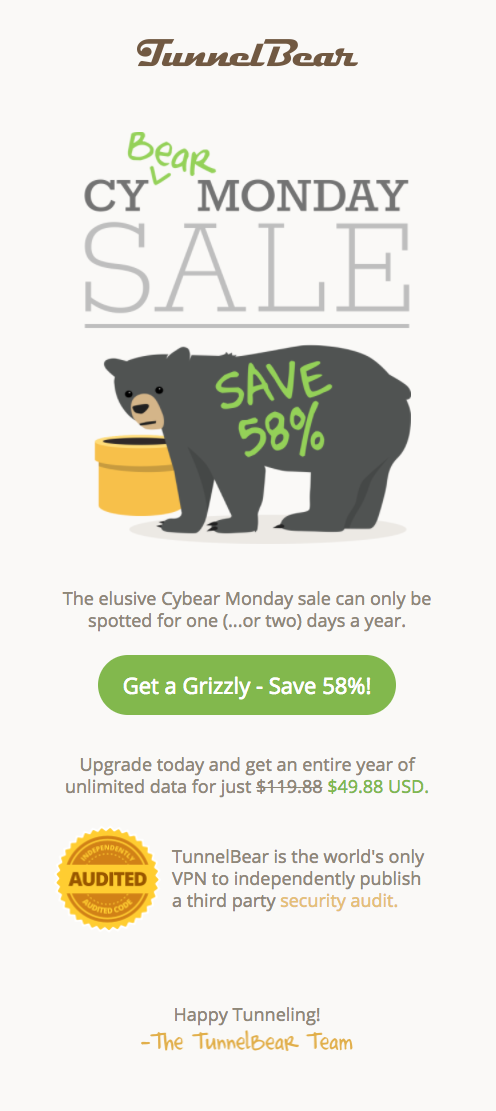
We mentioned that direct response marketing via email only works for customers in your current database. You cannot purchase or collect emails manually and send them offers — this is considered spam by all the email clients and can ruin your sender reputation.
But there is one more tactic to try: direct mail via the post. Don’t be shocked, it still exists and can bring you ROI if done properly. Neil Patel suggests you should include this channel in your marketing mix together with digital channels. Physical mail could be a cherry on the top of your campaign, bringing in a personal touch.
For instance, you can prepare nice postcards and include QR codes that will drive immediate action like event registration or even a purchase. This is how Mercedes promoted its car by using the flap of the envelope:

One more advantage of direct mail is that it is tangible. Even if a person does not act immediately, they may keep the card and remember about your discount or service when they need it.
There are GDPR compliant services like Postary that can help you send personalized postcards to customers. There you can design a postcard, select audiences, and send it within five days. They also allow you to track the efficiency of the campaign, using unique URLs and QR codes.
Direct response marketing tactics: target specific audiences
Personalization is one of the key marketing trends for 2020. The more relevant your ad is, the better: if you target the right person at the right moment, your offer will look like a solution to their problem or a great delight rather than an intrusive buy-or-die promotion.
Here are the targeting possibilities that exist in the main direct response channels:
| Facebook, Facebook Messenger | YouTube | Paid display | Email marketing | |
| Core audiences or potential prospects targeted based on location, demographics, interests, behavior, and connections. Custom audiences or people who already know your business: app users, site visitors, CRM contacts. Lookalike audiences or people similar to your current audiences. | Demographic groups and detailed demographics. Interests: affinity audiences, custom affinity audiences, life events, in-market audiences, custom intent audiences. Remarketing: video watchers, app users, website visitors. Customer match and similar audiences. | Location. Interests. Demographics. Behaviors. Custom audiences. Lookalike audiences. Automated targeting. | Demographic groups. Affinity. In-market. Custom intent. Similar audiences. Remarketing. | Your mailing list segments according to their behavior, customer journey stage, and demographics. |
Even direct mail can be targeted by using the Every Door Direct Mail option from usps.com!
Direct response marketing tactics: make a limited time offer
A decision usually takes time, that’s why your ad should be irresistible: emotional, captivating, and full of value.
If you want to upsell current customers, the wording can be concise and suggest the benefits of acting right now: a discount, a coupon, a give away, or free access.
If you are targeting potential customers, add your value proposition, unique selling points, and a short description of your product or service, including the pain points it can help solve.
For instance, if we get back to Wild Code School’s ad on Facebook, we’ll see:
- Pain point or need: “Looking to upskill or change careers?”
- Product description: “learning platform,” “coding school,” “prep course,” “learn basic concepts.”
- Unique selling points: “30+ hours,” “10 hours of lessons, exercises, and quizzes.”
- A thrilling offer: “FREE prep course.”
To make your offer even more attractive, add a time limit. This will instill a sense of urgency and fear of missing out. For instance, that’s how Good Pair Days used a last chance offer to convert leads into customers. They offered $25 off the first order with the promotion ending tomorrow. The subject line was: “Don’t miss out!”
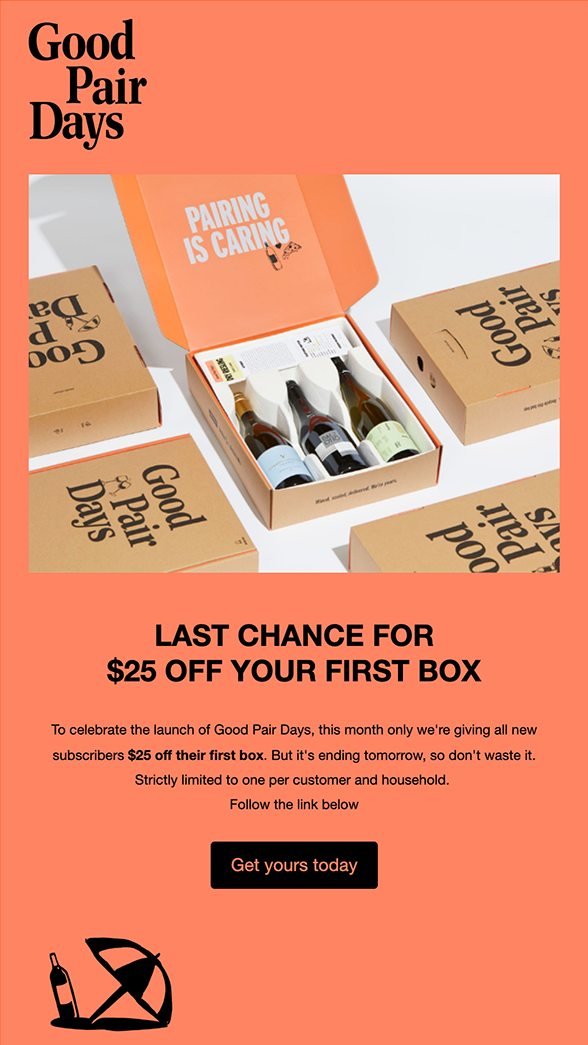
Direct response marketing tactics: use a strong CTA
Calls to action are one of the main elements of a direct response marketing campaign because they voice the action that a person should take.
Usually CTAs are concise and instill a sense of urgency: “download now,” “shop now,” “register now,” or “start a free trial.” Test different types of wording to get the most out of your CTA.
For instance, consider trying CTAs that demonstrate value. They might perform better than those just driving an action because people don’t look for a product — they look for the value behind it. To illustrate this, let’s take a look at this Freeletics Facebook ad:
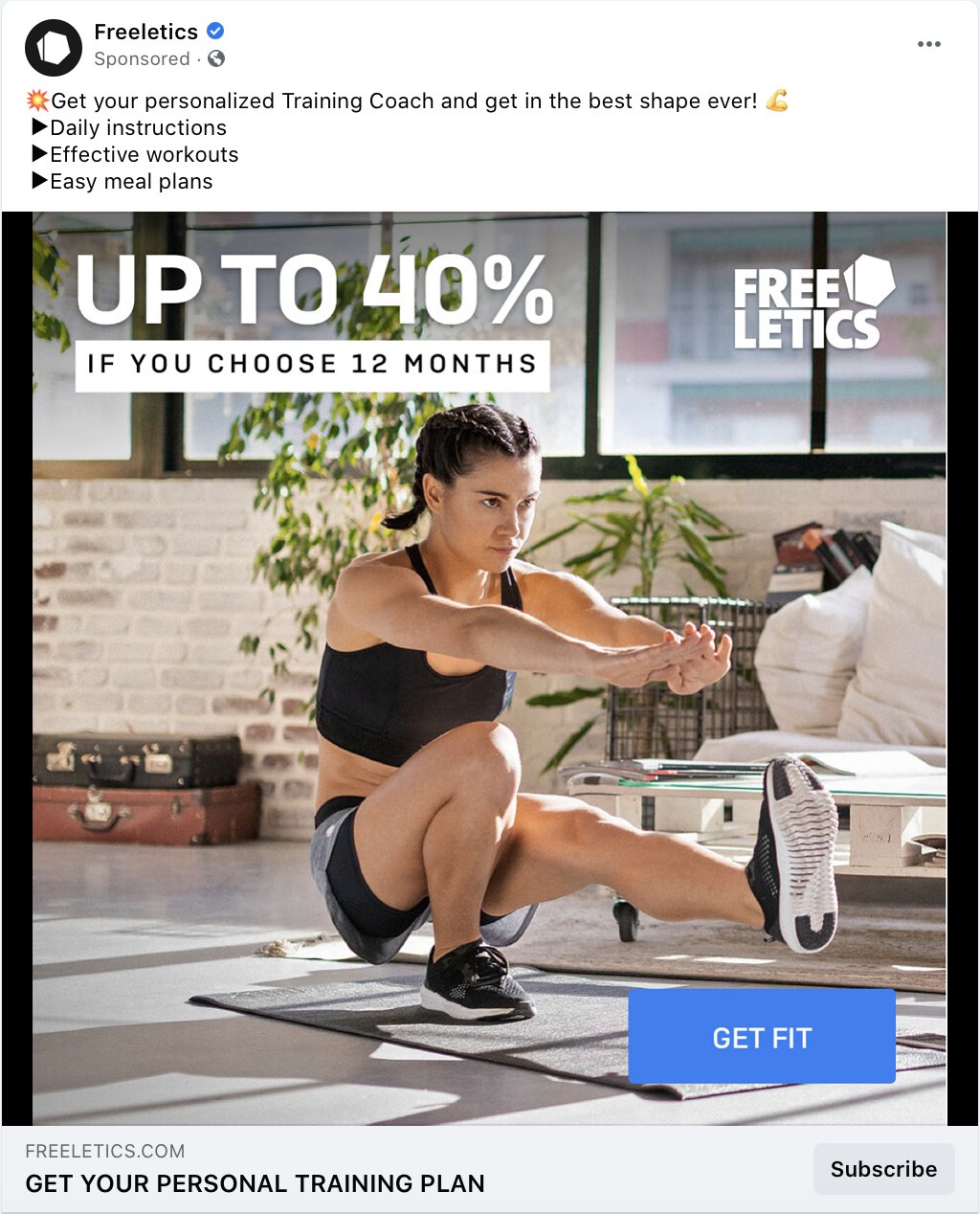
They use two types of CTAs: “Get fit” is a call to value and “Subscribe” is a standard call to action integrated into a Facebook ad. The “Get fit” button attracts much more attention and resonates with the audience better, because getting fit is their goal.
Direct response marketing tactics: make it easy to react
Whatever channel you use, make it easy to take action. With digital channels, it should be:
- a dedicated landing page;
- an item card if it’s an eCommerce site;
- a price list or a tariff page if it’s a subscription.
With traditional marketing channels like TV, radio, or direct mail:
- easy phone numbers;
- short links or QR codes leading to a dedicated landing page;
- clear instructions on what to do.
For instance, have a look at this direct mail example from KitKat. The goal of this coupon is to lead a person to a local grocery store. The instruction given is clear-cut: to get your free KitKat Chunky, take the card to the store with this specific address.
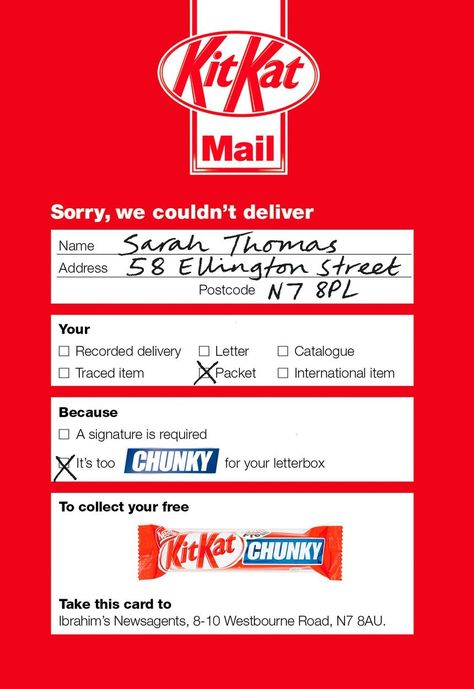
Direct response marketing tactics: track and measure outcomes
Track your campaigns in order to evaluate the best ones and scale them in the future. For this purpose, add UTM parameters to your links: these are pieces of code that help analytical services identify the most efficient channel, source, or campaign.
Building on that, analytical services collect stats and prepare reports to evaluate the efficiency of your direct response digital activities. If you use Google Analytics, make sure you set up conversion goals — they help to evaluate the ROI of each campaign you launch.
In summary
Direct response marketing is used to drive immediate action, inspiring your current or target audiences to purchase, subscribe, come to your store, or register for an event. It has its pros and cons and is best used when combined with inbound marketing, as the latter allows you to build relationships and brand awareness.
The best tactics to follow when using direct response marketing are:
- Pick the right channels. The best-converting ones according to Criteo are social media marketing, paid display ads, and email marketing. Email marketing can be used only with your current database and is limited to promotional or milestone emails.
- Target specific audiences. All the digital and even traditional direct response marketing channels have a wide range of targetings based on peoples demographics, behavior, and interests.
- Make a great offer with a time limit. Offer a discount, a voucher, or a giveaway. A time limit will drive immediate action due to the fear of missing out.
- Use a strong CTA. Test and evaluate different wordings, for example, consider using calls to value instead of calls to action.
- Make it easy to respond. If your consumers decided to take action, don’t make it difficult for them: create dedicated landing pages, anchor links, easy to dial phone numbers and short links.
- Track and measure outcomes. Otherwise, you won’t be able to evaluate your efficiency and ROI.
With SendPulse, you can create a three-in-one direct response marketing campaign to your current audiences: send emails, SMS, and chatbot messages. Sign up and enjoy!









